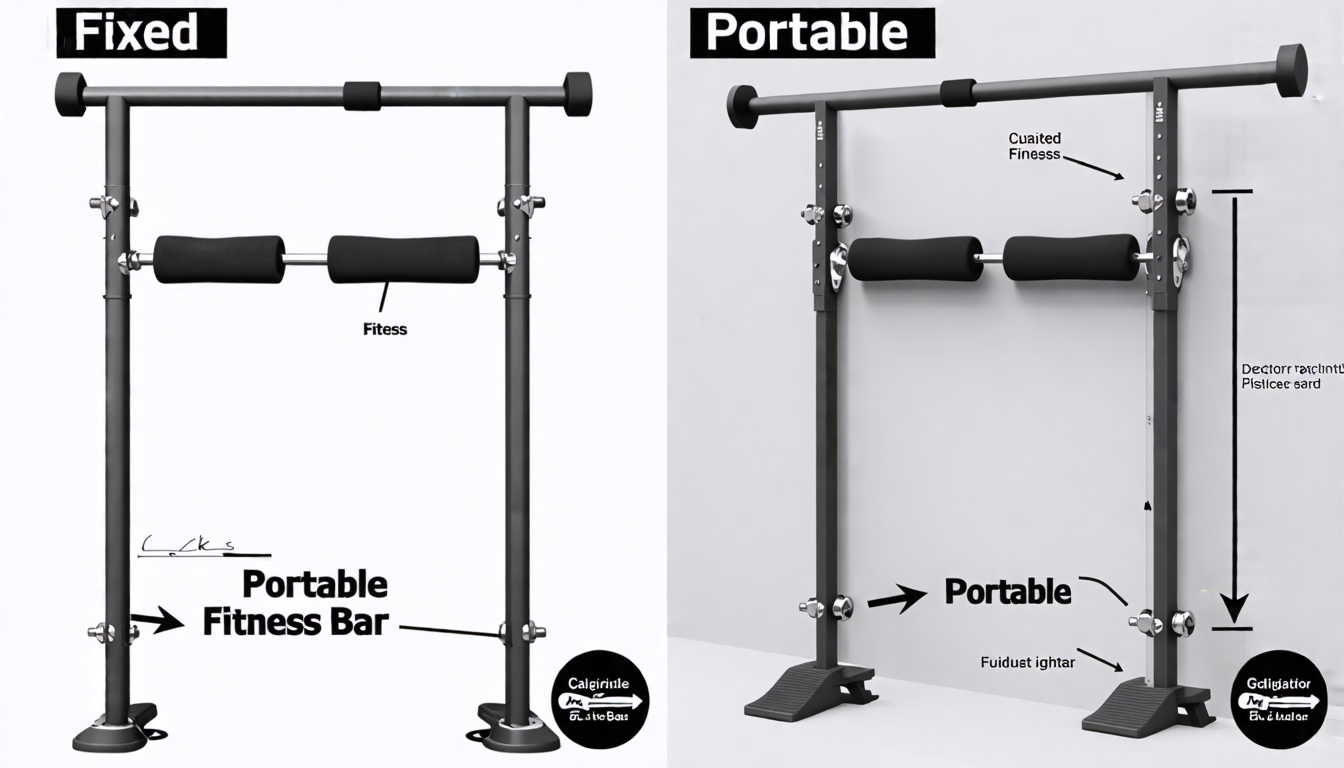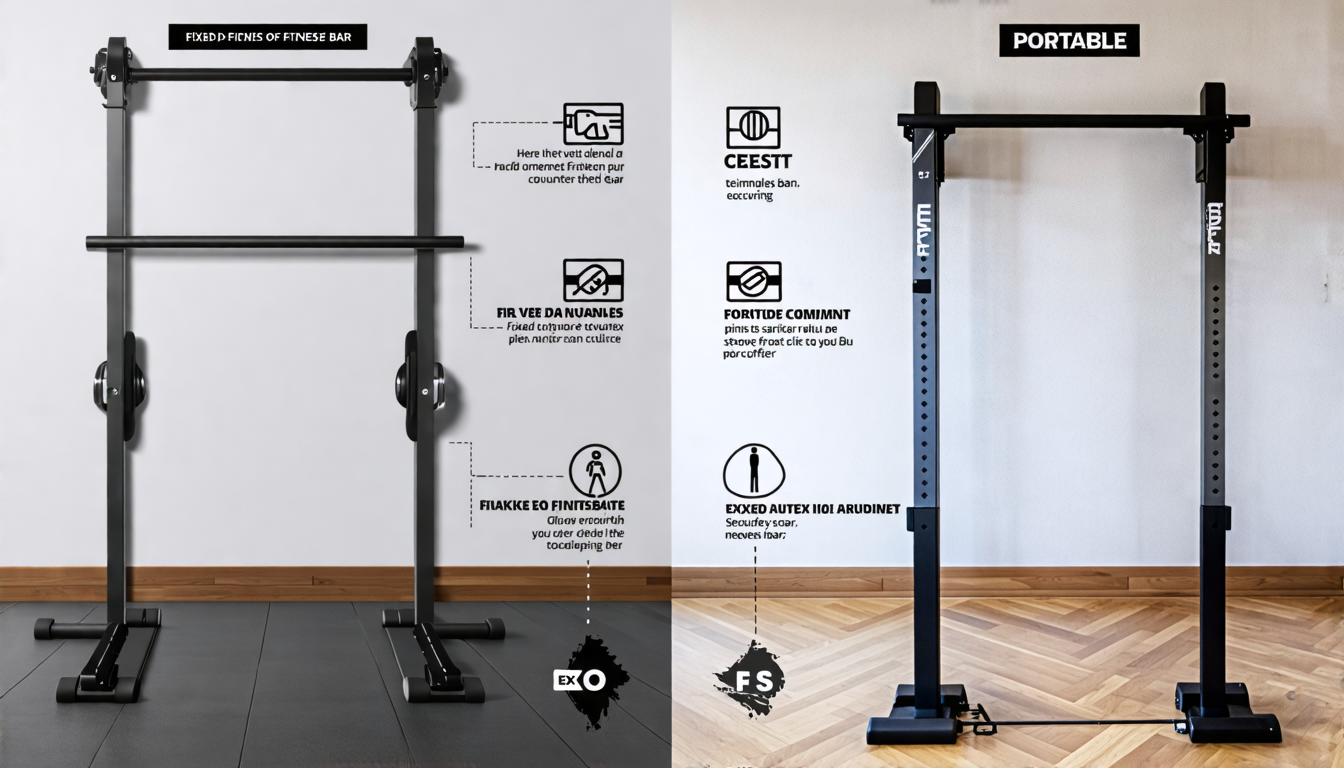In the world of home fitness, having the right equipment can make or break your workout regimen. Fitness bars, particularly fixed and portable versions, have soared in popularity due to their versatility and effectiveness in building strength, flexibility, and overall fitness. These fitness tools are particularly appealing for those looking to create a comprehensive fitness environment at home. With the increasing number of options available, it’s essential to understand the distinctions between fixed and portable fitness bars to make a well-informed decision that aligns with your fitness objectives.
Fixed fitness bars, as the name suggests, are permanently anchored in a specific location, typically on walls or ceilings. These bars are known for their robust construction and ability to support a significant amount of weight, making them ideal for intense workouts involving pull-ups, chin-ups, and other body-weight exercises. On the other hand, portable fitness bars are designed for mobility and convenience, allowing users to set them up and store them away with ease. These bars are usually lightweight and can be temporarily mounted on door frames or used as free-standing units, catering to those who need a flexible fitness solution that saves space.
Understanding the differences between fixed and portable fitness bars is crucial for anyone serious about home fitness. The choice between these two types of bars can impact the range of exercises you can perform, the level of convenience you experience, and the overall cost of your home gym setup. This article will delve into the key distinctions, highlighting the structural, functional, and practical aspects to consider, ultimately helping you choose the best fitness bar to achieve your personal training goals.
Introduction to Fixed and Portable Fitness Bars
Fitness bars, whether they are chin-up bars, dip bars, or push-up bars, have become incredibly popular in recent years. They offer a versatile workout tool for people looking to enhance their home fitness routines. These bars can be used to perform a wide variety of exercises that target different muscle groups, essential for building strength and maintaining overall fitness.
There are two main types of fitness bars: fixed and portable. Fixed fitness bars are permanently installed in a designated spot, often bolted into a wall, ceiling, or floor. They are usually made of heavy-duty materials, providing a sturdy and stable platform for challenging workouts. These bars are commonly found in home gyms, commercial fitness centers, and outdoor exercise parks.
On the other hand, portable fitness bars are designed for mobility and ease of use. They can be easily assembled and disassembled, allowing users to move them around and store them when not in use. Portable fitness bars are typically lighter and made from materials that balance durability with portability, like aluminum or high-strength plastic. They are ideal for individuals who want to work out in various locations or who have limited space in their homes.
Understanding the differences between fixed and portable fitness bars is crucial for choosing the right one to achieve your fitness goals. Each type has its own set of advantages and limitations, which can impact the effectiveness of your exercise regimen. By knowing what each type offers, you can make an informed decision that aligns with your specific needs and preferences.

Key Differences Between Fixed and Portable Fitness Bars
Structural and Design Distinctions
Material Composition and Durability
One of the significant distinctions between fixed and portable fitness bars is their material composition and durability. Fixed fitness bars are generally constructed from heavy-duty materials such as steel or wrought iron. These materials afford them robust strength, capable of supporting significant weights and enduring rigorous usage over a long period. Their permanent installation ensures that they remain stable and secure, making them a reliable option for intensive strength training exercises.
In contrast, portable fitness bars are usually made from lightweight materials like aluminum or high-grade plastic. While these materials provide the necessary strength for a variety of exercises, their primary advantage is their mobility. They are designed to be lightweight and often feature collapsible or adjustable components. This makes them easier to carry and store, making them an ideal choice for people who value flexibility and convenience in their workout regimen.
Installation Requirements and Settings Where Each is Used
The installation process and the settings in which fixed and portable fitness bars are used further set them apart. Fixed fitness bars require a dedicated installation process which may involve drilling, bolting, or welding to ensure they are securely affixed to a stable surface such as a wall, ceiling, or floor. This means they are best suited for permanent gym setups, whether at commercial facilities or home gyms with enough space for a stable setup.
On the other hand, portable fitness bars boast ease of setup and versatility in deployment. They can be quickly assembled, adjusted, and disassembled, making them apt for use in various environments—including living rooms, backyards, and even outdoor areas. Their non-invasive setup means they don’t require alterations to your home, often making them a more feasible option for those renting their living space or those who prefer to workout in multiple locations.
Functional Differences and Usage
Types of Exercises Best Suited for Each
The kinds of exercises you can perform with fixed and portable fitness bars can significantly impact your choice, depending on your fitness goals. Fixed fitness bars are ideal for exercises that require substantial weight support and stability. Common uses include pull-ups, chin-ups, muscle-ups, and other high-elevation strength training exercises. They are particularly beneficial for those engaged in progressive overload strength programs, as their stability supports the use of added weights, for instance, weight plates or resistance bands.
Portable fitness bars, however, are more geared toward a variety of body-weight exercises and can facilitate dynamic workouts involving movements like push-ups, dips, crunches, and even yoga and pilates for flexibility and balance. The adjustability feature of many portable bars means they can be tailored to various exercises, making them a multifaceted tool for diverse workout routines.
Advantages and Limitations in Terms of Convenience, Versatility, and Cost
When it comes to advantages and limitations, understanding how fixed and portable fitness bars differ in terms of convenience, versatility, and cost is crucial for home fitness enthusiasts. Fixed fitness bars offer unparalleled stability and are a mainstay for any serious weight-training program. However, they can be more expensive due to their material and the potential cost of professional installation. Additionally, their fixed nature means they lack versatility in terms of placement and mobility.
Conversely, portable fitness bars score high on convenience and versatility. They are often more affordable and do not require professional installation, making them accessible to a broader audience. Their portability allows for a flexible workout routine that can adapt to different environments and exercise needs. The downside is that they may not offer the same level of durability and stability as their fixed counterparts, potentially limiting their use for advanced strength training exercises involving substantial weights.
Fixed and portable fitness bars each offer unique benefits and constraints, making them suitable for different preferences and needs in the realm of home fitness. Fixed fitness bars, often made from robust materials and securely installed in a dedicated location, provide superior stability and durability. They are ideal for individuals focused on heavy lifting and intense strength training due to their capacity to support higher weights and withstand rigorous use. However, the need for permanent installation can limit flexibility and may not be suitable for homes with limited space or for those who frequently relocate.
On the other hand, portable fitness bars are celebrated for their convenience, versatility, and ease of assembly. Typically crafted from lightweight yet sturdy materials, these bars can be quickly set up and dismantled, making them an excellent choice for users who seek variety in their workout routines or have space constraints. Portable bars cater to a range of exercises, from pull-ups to resistance training, offering adaptability for diverse fitness goals. Despite their flexibility, they might not provide the same level of stability and are generally not recommended for very heavy lifting.
Ultimately, the choice between fixed and portable fitness bars hinges on individual workout preferences, space availability, and fitness goals. Those who prioritize stability and dedicated workout spaces may find fixed bars more beneficial, whereas individuals aiming for flexibility and convenience will appreciate the attributes of portable fitness bars. Understanding these differences is key to optimizing one’s home fitness setup and ensuring that the equipment aligns with their fitness objectives and lifestyle.
In conclusion, both fixed and portable fitness bars play valuable roles in home fitness regimes, each with distinct features that cater to different needs. By carefully considering the structural, functional, and practical distinctions, fitness enthusiasts can make informed decisions to enhance their workout experience and achieve their personal fitness goals.

